Occupational Hygiene and Safety: Comprehensive Risk Assessment Report
VerifiedAdded on 2023/06/07
|5
|1782
|70
Report
AI Summary
This report comprehensively examines occupational hygiene and safety risk assessment, emphasizing the anticipation, recognition, and evaluation of health risks in the work environment. It details the process of identifying workplace hazards, assessing their potential impact, and implementing control measures to protect workers and the community. The report explores various aspects of risk assessment, including the identification of hazards like noise, chemicals, and physical factors, and provides strategies for hazard elimination, control, and reduction. It highlights the employer's responsibility in assessing and mitigating risks, considering factors such as employee demographics and work conditions. The report also outlines risk assessment methodologies, the importance of stakeholder communication, and the role of legislation in preventing safety breaches. Furthermore, it details strategies for hazard management, including hierarchy of controls, medical examinations, and the provision of personal protective equipment. The report concludes with tables of risk occurrences and the frequency of risk assessments, along with risk communication strategies for stakeholders.
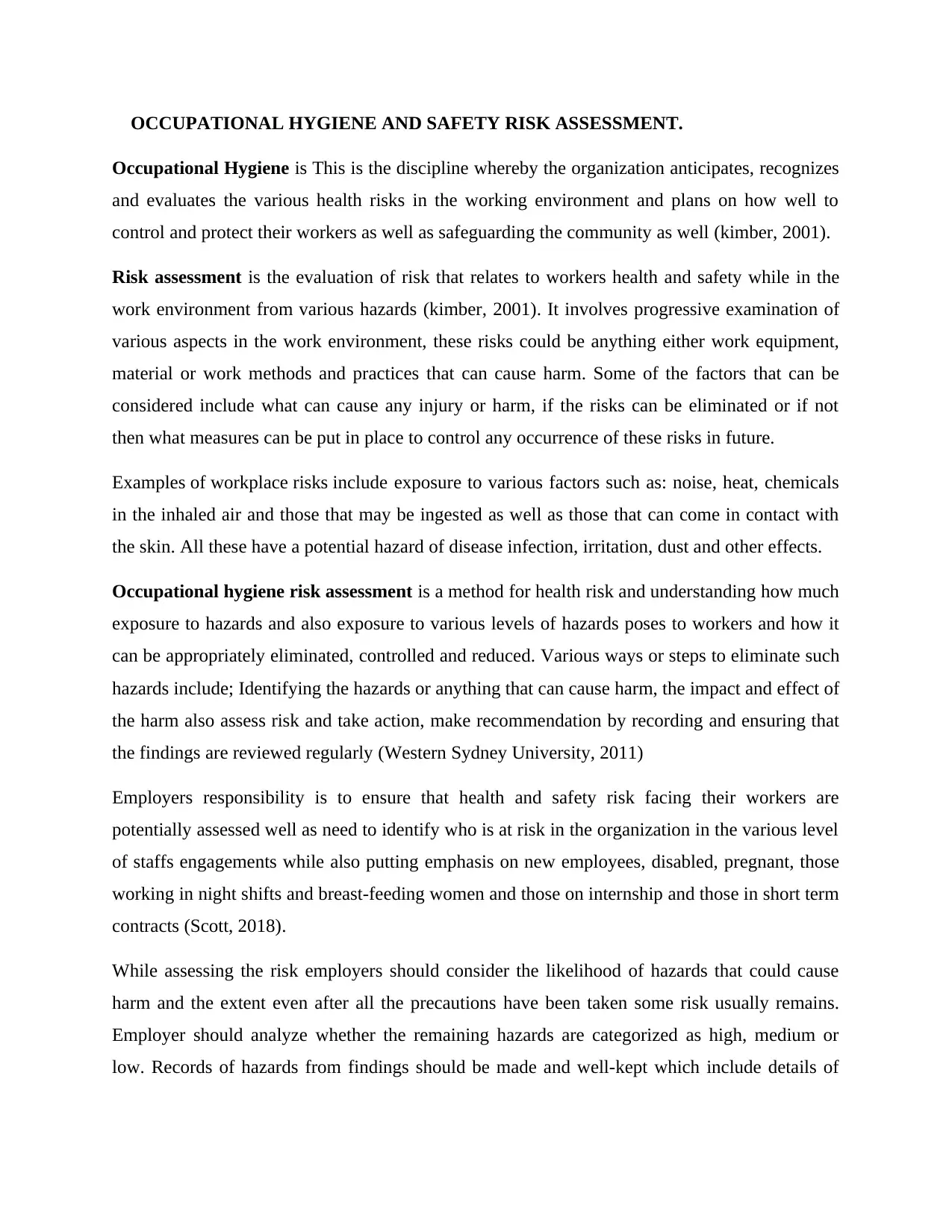
OCCUPATIONAL HYGIENE AND SAFETY RISK ASSESSMENT.
Occupational Hygiene is This is the discipline whereby the organization anticipates, recognizes
and evaluates the various health risks in the working environment and plans on how well to
control and protect their workers as well as safeguarding the community as well (kimber, 2001).
Risk assessment is the evaluation of risk that relates to workers health and safety while in the
work environment from various hazards (kimber, 2001). It involves progressive examination of
various aspects in the work environment, these risks could be anything either work equipment,
material or work methods and practices that can cause harm. Some of the factors that can be
considered include what can cause any injury or harm, if the risks can be eliminated or if not
then what measures can be put in place to control any occurrence of these risks in future.
Examples of workplace risks include exposure to various factors such as: noise, heat, chemicals
in the inhaled air and those that may be ingested as well as those that can come in contact with
the skin. All these have a potential hazard of disease infection, irritation, dust and other effects.
Occupational hygiene risk assessment is a method for health risk and understanding how much
exposure to hazards and also exposure to various levels of hazards poses to workers and how it
can be appropriately eliminated, controlled and reduced. Various ways or steps to eliminate such
hazards include; Identifying the hazards or anything that can cause harm, the impact and effect of
the harm also assess risk and take action, make recommendation by recording and ensuring that
the findings are reviewed regularly (Western Sydney University, 2011)
Employers responsibility is to ensure that health and safety risk facing their workers are
potentially assessed well as need to identify who is at risk in the organization in the various level
of staffs engagements while also putting emphasis on new employees, disabled, pregnant, those
working in night shifts and breast-feeding women and those on internship and those in short term
contracts (Scott, 2018).
While assessing the risk employers should consider the likelihood of hazards that could cause
harm and the extent even after all the precautions have been taken some risk usually remains.
Employer should analyze whether the remaining hazards are categorized as high, medium or
low. Records of hazards from findings should be made and well-kept which include details of
Occupational Hygiene is This is the discipline whereby the organization anticipates, recognizes
and evaluates the various health risks in the working environment and plans on how well to
control and protect their workers as well as safeguarding the community as well (kimber, 2001).
Risk assessment is the evaluation of risk that relates to workers health and safety while in the
work environment from various hazards (kimber, 2001). It involves progressive examination of
various aspects in the work environment, these risks could be anything either work equipment,
material or work methods and practices that can cause harm. Some of the factors that can be
considered include what can cause any injury or harm, if the risks can be eliminated or if not
then what measures can be put in place to control any occurrence of these risks in future.
Examples of workplace risks include exposure to various factors such as: noise, heat, chemicals
in the inhaled air and those that may be ingested as well as those that can come in contact with
the skin. All these have a potential hazard of disease infection, irritation, dust and other effects.
Occupational hygiene risk assessment is a method for health risk and understanding how much
exposure to hazards and also exposure to various levels of hazards poses to workers and how it
can be appropriately eliminated, controlled and reduced. Various ways or steps to eliminate such
hazards include; Identifying the hazards or anything that can cause harm, the impact and effect of
the harm also assess risk and take action, make recommendation by recording and ensuring that
the findings are reviewed regularly (Western Sydney University, 2011)
Employers responsibility is to ensure that health and safety risk facing their workers are
potentially assessed well as need to identify who is at risk in the organization in the various level
of staffs engagements while also putting emphasis on new employees, disabled, pregnant, those
working in night shifts and breast-feeding women and those on internship and those in short term
contracts (Scott, 2018).
While assessing the risk employers should consider the likelihood of hazards that could cause
harm and the extent even after all the precautions have been taken some risk usually remains.
Employer should analyze whether the remaining hazards are categorized as high, medium or
low. Records of hazards from findings should be made and well-kept which include details of
Paraphrase This Document
Need a fresh take? Get an instant paraphrase of this document with our AI Paraphraser
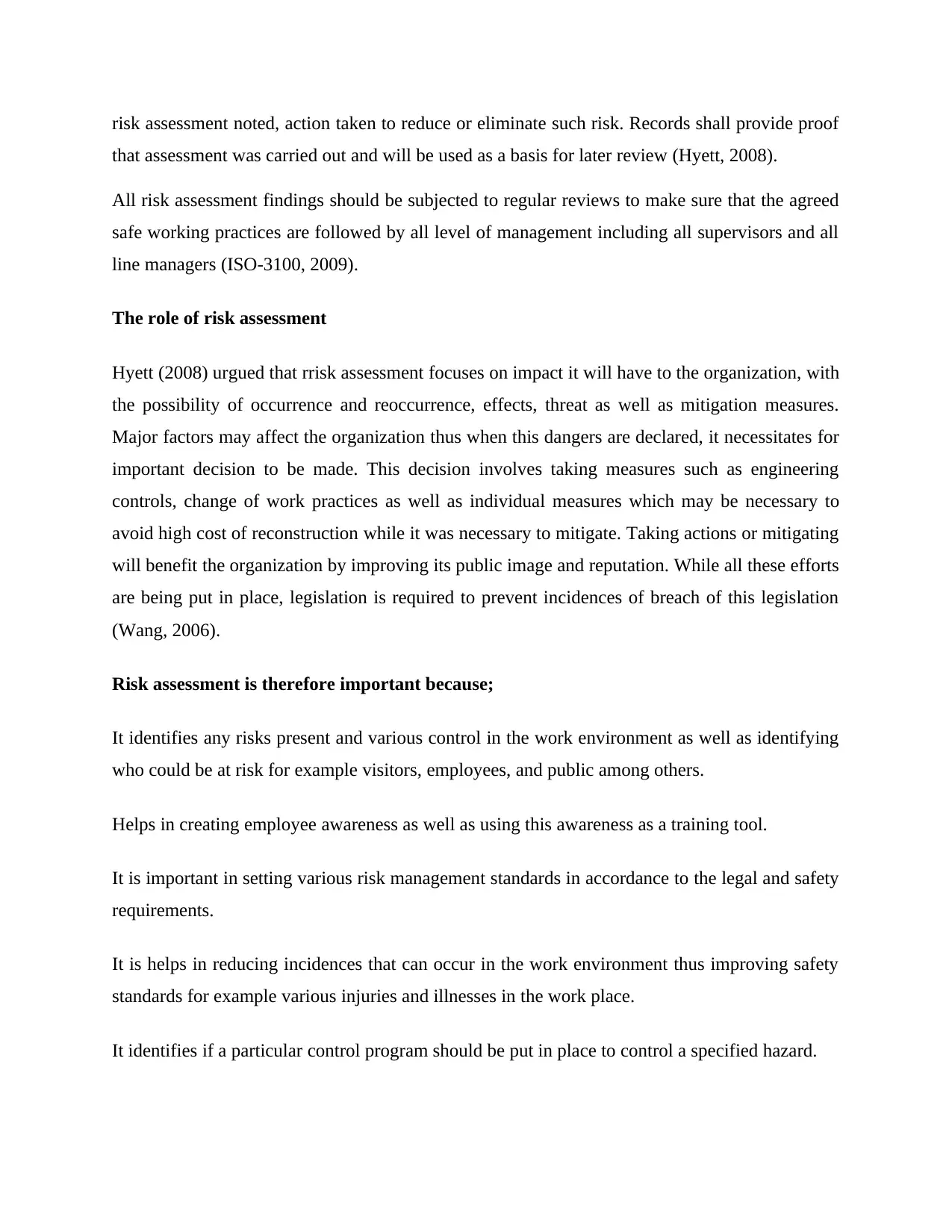
risk assessment noted, action taken to reduce or eliminate such risk. Records shall provide proof
that assessment was carried out and will be used as a basis for later review (Hyett, 2008).
All risk assessment findings should be subjected to regular reviews to make sure that the agreed
safe working practices are followed by all level of management including all supervisors and all
line managers (ISO-3100, 2009).
The role of risk assessment
Hyett (2008) urgued that rrisk assessment focuses on impact it will have to the organization, with
the possibility of occurrence and reoccurrence, effects, threat as well as mitigation measures.
Major factors may affect the organization thus when this dangers are declared, it necessitates for
important decision to be made. This decision involves taking measures such as engineering
controls, change of work practices as well as individual measures which may be necessary to
avoid high cost of reconstruction while it was necessary to mitigate. Taking actions or mitigating
will benefit the organization by improving its public image and reputation. While all these efforts
are being put in place, legislation is required to prevent incidences of breach of this legislation
(Wang, 2006).
Risk assessment is therefore important because;
It identifies any risks present and various control in the work environment as well as identifying
who could be at risk for example visitors, employees, and public among others.
Helps in creating employee awareness as well as using this awareness as a training tool.
It is important in setting various risk management standards in accordance to the legal and safety
requirements.
It is helps in reducing incidences that can occur in the work environment thus improving safety
standards for example various injuries and illnesses in the work place.
It identifies if a particular control program should be put in place to control a specified hazard.
that assessment was carried out and will be used as a basis for later review (Hyett, 2008).
All risk assessment findings should be subjected to regular reviews to make sure that the agreed
safe working practices are followed by all level of management including all supervisors and all
line managers (ISO-3100, 2009).
The role of risk assessment
Hyett (2008) urgued that rrisk assessment focuses on impact it will have to the organization, with
the possibility of occurrence and reoccurrence, effects, threat as well as mitigation measures.
Major factors may affect the organization thus when this dangers are declared, it necessitates for
important decision to be made. This decision involves taking measures such as engineering
controls, change of work practices as well as individual measures which may be necessary to
avoid high cost of reconstruction while it was necessary to mitigate. Taking actions or mitigating
will benefit the organization by improving its public image and reputation. While all these efforts
are being put in place, legislation is required to prevent incidences of breach of this legislation
(Wang, 2006).
Risk assessment is therefore important because;
It identifies any risks present and various control in the work environment as well as identifying
who could be at risk for example visitors, employees, and public among others.
Helps in creating employee awareness as well as using this awareness as a training tool.
It is important in setting various risk management standards in accordance to the legal and safety
requirements.
It is helps in reducing incidences that can occur in the work environment thus improving safety
standards for example various injuries and illnesses in the work place.
It identifies if a particular control program should be put in place to control a specified hazard.
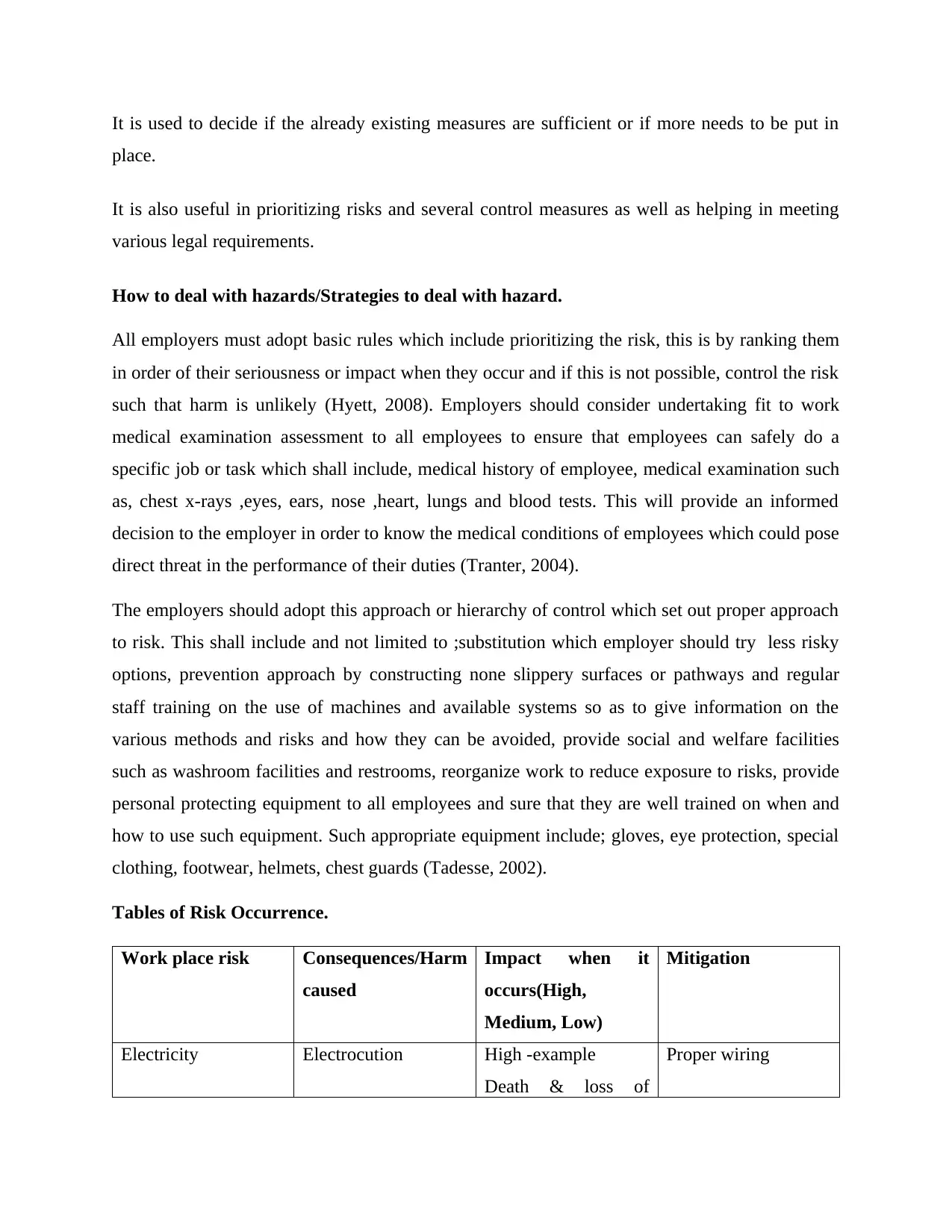
It is used to decide if the already existing measures are sufficient or if more needs to be put in
place.
It is also useful in prioritizing risks and several control measures as well as helping in meeting
various legal requirements.
How to deal with hazards/Strategies to deal with hazard.
All employers must adopt basic rules which include prioritizing the risk, this is by ranking them
in order of their seriousness or impact when they occur and if this is not possible, control the risk
such that harm is unlikely (Hyett, 2008). Employers should consider undertaking fit to work
medical examination assessment to all employees to ensure that employees can safely do a
specific job or task which shall include, medical history of employee, medical examination such
as, chest x-rays ,eyes, ears, nose ,heart, lungs and blood tests. This will provide an informed
decision to the employer in order to know the medical conditions of employees which could pose
direct threat in the performance of their duties (Tranter, 2004).
The employers should adopt this approach or hierarchy of control which set out proper approach
to risk. This shall include and not limited to ;substitution which employer should try less risky
options, prevention approach by constructing none slippery surfaces or pathways and regular
staff training on the use of machines and available systems so as to give information on the
various methods and risks and how they can be avoided, provide social and welfare facilities
such as washroom facilities and restrooms, reorganize work to reduce exposure to risks, provide
personal protecting equipment to all employees and sure that they are well trained on when and
how to use such equipment. Such appropriate equipment include; gloves, eye protection, special
clothing, footwear, helmets, chest guards (Tadesse, 2002).
Tables of Risk Occurrence.
Work place risk Consequences/Harm
caused
Impact when it
occurs(High,
Medium, Low)
Mitigation
Electricity Electrocution High -example
Death & loss of
Proper wiring
place.
It is also useful in prioritizing risks and several control measures as well as helping in meeting
various legal requirements.
How to deal with hazards/Strategies to deal with hazard.
All employers must adopt basic rules which include prioritizing the risk, this is by ranking them
in order of their seriousness or impact when they occur and if this is not possible, control the risk
such that harm is unlikely (Hyett, 2008). Employers should consider undertaking fit to work
medical examination assessment to all employees to ensure that employees can safely do a
specific job or task which shall include, medical history of employee, medical examination such
as, chest x-rays ,eyes, ears, nose ,heart, lungs and blood tests. This will provide an informed
decision to the employer in order to know the medical conditions of employees which could pose
direct threat in the performance of their duties (Tranter, 2004).
The employers should adopt this approach or hierarchy of control which set out proper approach
to risk. This shall include and not limited to ;substitution which employer should try less risky
options, prevention approach by constructing none slippery surfaces or pathways and regular
staff training on the use of machines and available systems so as to give information on the
various methods and risks and how they can be avoided, provide social and welfare facilities
such as washroom facilities and restrooms, reorganize work to reduce exposure to risks, provide
personal protecting equipment to all employees and sure that they are well trained on when and
how to use such equipment. Such appropriate equipment include; gloves, eye protection, special
clothing, footwear, helmets, chest guards (Tadesse, 2002).
Tables of Risk Occurrence.
Work place risk Consequences/Harm
caused
Impact when it
occurs(High,
Medium, Low)
Mitigation
Electricity Electrocution High -example
Death & loss of
Proper wiring
⊘ This is a preview!⊘
Do you want full access?
Subscribe today to unlock all pages.

Trusted by 1+ million students worldwide
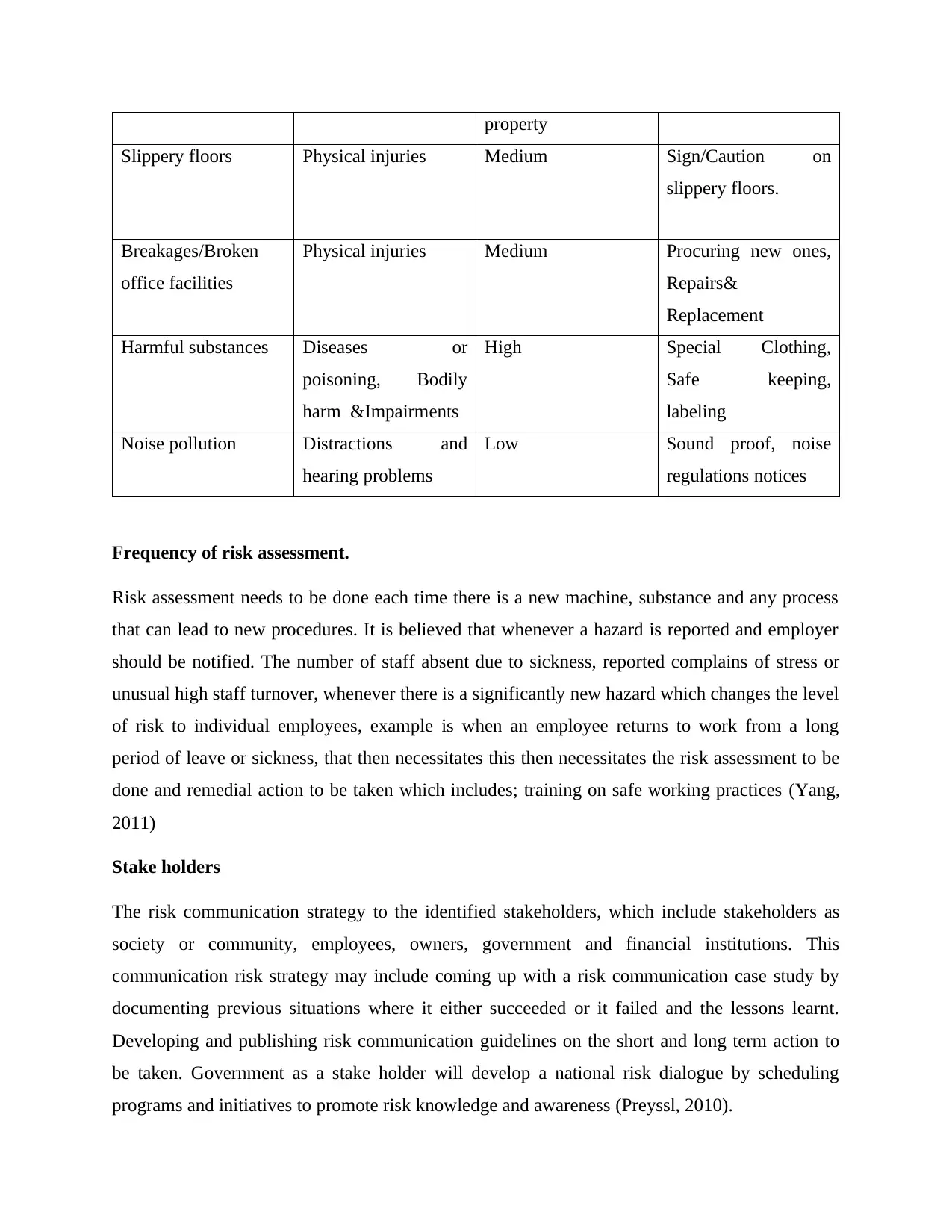
property
Slippery floors Physical injuries Medium Sign/Caution on
slippery floors.
Breakages/Broken
office facilities
Physical injuries Medium Procuring new ones,
Repairs&
Replacement
Harmful substances Diseases or
poisoning, Bodily
harm &Impairments
High Special Clothing,
Safe keeping,
labeling
Noise pollution Distractions and
hearing problems
Low Sound proof, noise
regulations notices
Frequency of risk assessment.
Risk assessment needs to be done each time there is a new machine, substance and any process
that can lead to new procedures. It is believed that whenever a hazard is reported and employer
should be notified. The number of staff absent due to sickness, reported complains of stress or
unusual high staff turnover, whenever there is a significantly new hazard which changes the level
of risk to individual employees, example is when an employee returns to work from a long
period of leave or sickness, that then necessitates this then necessitates the risk assessment to be
done and remedial action to be taken which includes; training on safe working practices (Yang,
2011)
Stake holders
The risk communication strategy to the identified stakeholders, which include stakeholders as
society or community, employees, owners, government and financial institutions. This
communication risk strategy may include coming up with a risk communication case study by
documenting previous situations where it either succeeded or it failed and the lessons learnt.
Developing and publishing risk communication guidelines on the short and long term action to
be taken. Government as a stake holder will develop a national risk dialogue by scheduling
programs and initiatives to promote risk knowledge and awareness (Preyssl, 2010).
Slippery floors Physical injuries Medium Sign/Caution on
slippery floors.
Breakages/Broken
office facilities
Physical injuries Medium Procuring new ones,
Repairs&
Replacement
Harmful substances Diseases or
poisoning, Bodily
harm &Impairments
High Special Clothing,
Safe keeping,
labeling
Noise pollution Distractions and
hearing problems
Low Sound proof, noise
regulations notices
Frequency of risk assessment.
Risk assessment needs to be done each time there is a new machine, substance and any process
that can lead to new procedures. It is believed that whenever a hazard is reported and employer
should be notified. The number of staff absent due to sickness, reported complains of stress or
unusual high staff turnover, whenever there is a significantly new hazard which changes the level
of risk to individual employees, example is when an employee returns to work from a long
period of leave or sickness, that then necessitates this then necessitates the risk assessment to be
done and remedial action to be taken which includes; training on safe working practices (Yang,
2011)
Stake holders
The risk communication strategy to the identified stakeholders, which include stakeholders as
society or community, employees, owners, government and financial institutions. This
communication risk strategy may include coming up with a risk communication case study by
documenting previous situations where it either succeeded or it failed and the lessons learnt.
Developing and publishing risk communication guidelines on the short and long term action to
be taken. Government as a stake holder will develop a national risk dialogue by scheduling
programs and initiatives to promote risk knowledge and awareness (Preyssl, 2010).
Paraphrase This Document
Need a fresh take? Get an instant paraphrase of this document with our AI Paraphraser
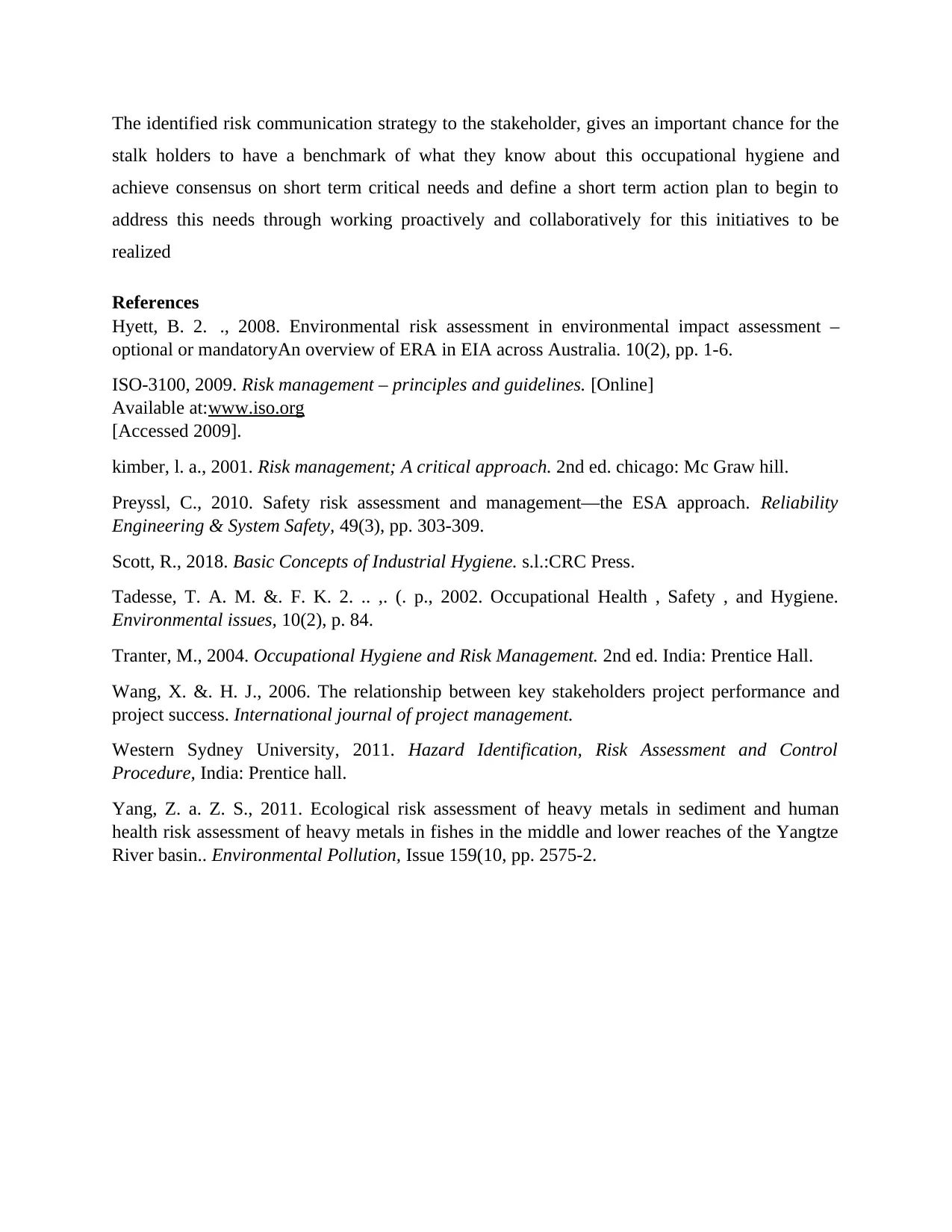
The identified risk communication strategy to the stakeholder, gives an important chance for the
stalk holders to have a benchmark of what they know about this occupational hygiene and
achieve consensus on short term critical needs and define a short term action plan to begin to
address this needs through working proactively and collaboratively for this initiatives to be
realized
References
Hyett, B. 2. ., 2008. Environmental risk assessment in environmental impact assessment –
optional or mandatoryAn overview of ERA in EIA across Australia. 10(2), pp. 1-6.
ISO-3100, 2009. Risk management – principles and guidelines. [Online]
Available at:www.iso.org
[Accessed 2009].
kimber, l. a., 2001. Risk management; A critical approach. 2nd ed. chicago: Mc Graw hill.
Preyssl, C., 2010. Safety risk assessment and management—the ESA approach. Reliability
Engineering & System Safety, 49(3), pp. 303-309.
Scott, R., 2018. Basic Concepts of Industrial Hygiene. s.l.:CRC Press.
Tadesse, T. A. M. &. F. K. 2. .. ,. (. p., 2002. Occupational Health , Safety , and Hygiene.
Environmental issues, 10(2), p. 84.
Tranter, M., 2004. Occupational Hygiene and Risk Management. 2nd ed. India: Prentice Hall.
Wang, X. &. H. J., 2006. The relationship between key stakeholders project performance and
project success. International journal of project management.
Western Sydney University, 2011. Hazard Identification, Risk Assessment and Control
Procedure, India: Prentice hall.
Yang, Z. a. Z. S., 2011. Ecological risk assessment of heavy metals in sediment and human
health risk assessment of heavy metals in fishes in the middle and lower reaches of the Yangtze
River basin.. Environmental Pollution, Issue 159(10, pp. 2575-2.
stalk holders to have a benchmark of what they know about this occupational hygiene and
achieve consensus on short term critical needs and define a short term action plan to begin to
address this needs through working proactively and collaboratively for this initiatives to be
realized
References
Hyett, B. 2. ., 2008. Environmental risk assessment in environmental impact assessment –
optional or mandatoryAn overview of ERA in EIA across Australia. 10(2), pp. 1-6.
ISO-3100, 2009. Risk management – principles and guidelines. [Online]
Available at:www.iso.org
[Accessed 2009].
kimber, l. a., 2001. Risk management; A critical approach. 2nd ed. chicago: Mc Graw hill.
Preyssl, C., 2010. Safety risk assessment and management—the ESA approach. Reliability
Engineering & System Safety, 49(3), pp. 303-309.
Scott, R., 2018. Basic Concepts of Industrial Hygiene. s.l.:CRC Press.
Tadesse, T. A. M. &. F. K. 2. .. ,. (. p., 2002. Occupational Health , Safety , and Hygiene.
Environmental issues, 10(2), p. 84.
Tranter, M., 2004. Occupational Hygiene and Risk Management. 2nd ed. India: Prentice Hall.
Wang, X. &. H. J., 2006. The relationship between key stakeholders project performance and
project success. International journal of project management.
Western Sydney University, 2011. Hazard Identification, Risk Assessment and Control
Procedure, India: Prentice hall.
Yang, Z. a. Z. S., 2011. Ecological risk assessment of heavy metals in sediment and human
health risk assessment of heavy metals in fishes in the middle and lower reaches of the Yangtze
River basin.. Environmental Pollution, Issue 159(10, pp. 2575-2.
1 out of 5
Related Documents
Your All-in-One AI-Powered Toolkit for Academic Success.
+13062052269
info@desklib.com
Available 24*7 on WhatsApp / Email
![[object Object]](/_next/static/media/star-bottom.7253800d.svg)
Unlock your academic potential
Copyright © 2020–2025 A2Z Services. All Rights Reserved. Developed and managed by ZUCOL.




